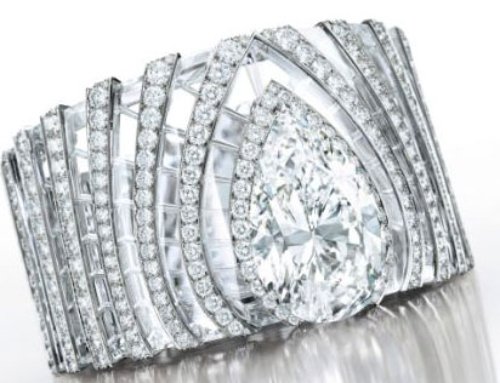The diamond industry has moved from a relatively stable environment to a highly uncertain environment, with 2019 and the years ahead seeing lab-grown diamonds for jewelry entering a growth phase, said ABN AMRO Bank in a report.
The launch by De Beers of its lab-grown diamond jewelry line “has serious consequences for the actors in the diamond industry,” according to the ABN Amro report. “Natural diamond buyers such as retailers, consumers and jewelry manufacturers) will likely de-stock and hold less inventory. This will result in lower demand for natural diamonds and weigh on prices. Miners will rethink their strategy in light of uncertainty about natural diamond demand, and questions about the value of a diamond. Lab-grown diamond producers will probably focus on technology to become less energy dependent, or use more sustainable energy sources, to increase the product suite and lower prices for the lab-grown diamonds used in jewelry. Consumers will profit from the wider variety of diamonds at more attractive prices.”
The ABN Amro report is as follows:
At the end of 2017, we published the following report: Diamond Sector Outlook – Nothing is Forever – part 2…
In this report we came to the conclusion that the diamond industry has moved from a relatively stable environment to a highly dynamic environment. The miners and the rough diamond buyers have adopted different strategies to face the new environment. The large mining companies have adopted control strategies (for example buyer’s acceptance standards, selling of lab-grown diamond detection machines) and they are positioned for a larger role for lab-grown diamonds.
On 29 May De Beers launched a laboratory-grown diamond jewelry brand, Lightbox Jewellery. This was a shock to the industry. Gem-quality lab-grown diamonds threaten the business case of miners, now even more so than before. This has created a lot of uncertainty in the diamond industry. If 2018 was the year that lab-grown jewelry diamonds were officially introduced as an acceptable new product, what will 2019 bring?
The concept of lab-grown diamonds was not new. Lab-grown diamonds were already used for industrial purposes. 99% of all the industrial diamonds are lab-grown diamonds. Lab-grown diamonds are already there for some years (also for jewelry purposes) but because of De Beers’ Lightbox announcement it has become more legitimate. There are several reasons for this. For a start, De Beers fought various court battles that their unit Element Six (the unit of De Beers that designs, develops and produces lab-grown diamonds) holds the technology. For a while De Beers was successful in limiting competition through the ownership of lab-grown diamond technology. Recently, more producers have been able to produce lab-grown diamonds.
As a result, competition in the technology for lab-grown diamonds has taken off. In addition, the technology has progressed rapidly. Not only are lab-grown diamond producers able to produce bigger stones than before (more carats) but also better quality stones (for example better clarity and color). Moreover, there seems to be a higher acceptance among consumers. This is probably driven by the perception that lab-grown diamonds are more sustainable and the price/quality could be more attractive. In our report of December 2017 we made the case that lab-grown diamonds are indeed more sustainable (probably less than the industry claims) compared to diamonds mined via large mining operations and via artisanal mining. The main costs for lab-grown diamonds are energy. If lab-grown diamond producers are able to use more sustainable energy sources, lab-grown diamonds will become yet more sustainable. In order for mined diamonds to compete in terms of sustainability, mining companies would need to make much bigger changes to their mining methods.
For a long time both diamond mining companies and most parties in the diamond supply chain strongly resisted the entry of lab-grown diamonds into the overall diamond industry. This was because there was no transparent use of lab-grown diamonds. There have been reports that they were mixed with natural diamonds or lab-grown diamonds were linked to a natural diamond report from a grading laboratory. The launch of Lightbox Jewellery by De Beers therefore shocked the industry, and now all the bets are off. For us, 2018 was the year that lab-grown diamonds got a place in the jewelry industry. We think that this was the first phase (introduction) in the product life cycle.
Growth Phase For Lab-Grown Diamonds For The Years Ahead
ABN Amro thinks that 2019 and 2020 will be the years that lab-grown diamonds take off and move from an introduction phase (2018) to a growth phase. Lab-grown diamond producers have been able to produce larger and better-quality lab-grown diamonds. Moreover, more companies and persons in the diamond industry are willing to jump on the lab-grown diamond experience. For example, New Diamond Technology LLC – a Russian company – has announced that it has produced a 103.50 carat lab-grown diamond. This is the largest ever lab-grown diamond. Moreover, Lightbox plans to sell its lab-grown diamond jewelry not only via its own website but also has said that it will enter into partnerships with retailers for online and in-store sales. In future there will most likely be a wider variety of colors. Lightbox and some other lab-grown diamond (jewelry) providers have decided to leave wedding jewelry or engagement rings out of the offering (for now). We think sooner rather than later lab-grown diamond wedding jewelry will be part of the offering.
This New Phase Will Directly Impact The Strategy Of Buyers…
De Beers continues to focus on a differentiation strategy between natural diamonds and lab-grown diamonds. This is to ensure that higher demand for lab-grown diamonds via Lightbox will not cannibalize demand for natural diamonds. The effects of lab-grown diamonds have already been felt in the lower grade and quality stones as well as in the smallest pieces. This is not the segment where the margin is. Larger and higher quality stones have a more attractive margin. But the margin on the largest high quality stones is already under pressure. Currently a considerable number of large natural diamonds are found (because of an improved mining process) and this puts pressure on prices as they are perceived as less rare than before.
Besides this development, the diamond industry seems to believe that these larger and higher quality stones will not face serious competition from lab-grown diamonds. We think that because of technology and the attractive margins in this segment, it is just a matter of time before the larger stones will also face serious competition from lab-grown diamonds. As a result, it is likely or even recommended that the inventory of natural diamonds decreases, as there is great uncertainty about the future value of natural diamonds. So traders and other buyers will probably hold lower inventories and be less aggressive in buying new diamonds. In addition, jewelry houses will decide whether they will offer lab-grown diamond jewelry pieces or not. If they were to offer lab-grown diamond jewelry as well, they would probably adjust the offering of natural diamond jewelry accordingly. As a result, it is likely that demand for natural diamonds will decline.
… And Diamond Manufacturers
Manufacturers will polish both natural and lab-grown diamonds. The polishing of lab-grown diamonds could be somewhat different as the growth-structure differs (flat, cubic or octahedral growth structures). Most natural diamonds have an octahedral or dodecahedral growth structure. An octahedral natural diamond will be cut in two, resulting in a larger round brilliant diamond and a smaller brilliant diamond. If the growth form is cubic there are other possibilities to cut and polish diamonds. In short, the skill-set of the polisher will be enhanced in this new phase of growth.
The Miners To Rethink Their Strategies
The natural diamond miners will have some possible strategies to brace for the growth of lab-grown diamonds. First, they could speed up mining activity to cash in on their diamond reserves. In a few years from now it is highly uncertain if natural diamonds will hold their value as always has been assumed. Some producers and/or countries have indicated that they will step up production in the future. De Beers has announced that it expects output for 2018 to reach 35 to 36 million carats. This is the highest output since 2008. In 2019 there will probably be a fall in output because of some production challenges, but the output for 2020 and 2021 is expected to surpass the level of 2018. Moreover, Angola has signaled that it will double production. It is unclear if the step-up in production has anything to do with the developments in lab-grown diamonds. However, Alrosa has indicated that it will hold back supply in 2019 to avoid flooding the market.
Second, the miners could stop searching for new mines as the high exploration costs will unlikely be paid back by future income from natural diamonds. Moreover, in recent years more large and high quality diamonds been discovered. This has weighed on the prices of these diamonds. In addition, it is likely that the price of the smaller and less desirable diamonds will decline as they can’t compete with lab-grown diamonds. So these diamonds will lose their attractiveness. The reasonable quality and diamonds larger than 0.5 carat still have value.
But if consumers were to increasingly opt for the lab-grown diamond jewelry this would negatively impact demand for natural diamonds. Consumers will probably get a larger and better quality stones for their money. As a result, it is likely that natural diamonds will decline in value because of lower demand.
Third, miners could launch lab-grown diamonds or team up with a lab-grown diamond producer. We think this will increase the future survival changes of a natural diamond miner.
… And Lab-Grown Diamond Producers To Position For Stronger Competition
The lab-grown diamond producers also have a few strategies to survive in this highly uncertain environment. First, they can secure the energy supply and in particular find cheaper and more sustainable sources of energy. This will enable the lab-grown diamond producer to produce more cheaply, improving their competitiveness. Moreover, with more sustainable energy sources they will be able to fight the perception that they may not be as sustainable as perceived.
Second, lab-grown diamond producers can focus on technology. This could result in lower energy and production costs as well as a wider product range. A wider product range would mean larger stones, better quality stones or a wider variety of colors. If a lab-grown producer is able to produce a wider range of products, they would be able to focus on a niche, or offer the full range. In short, it will give them more survival strategies.
Third, lab-grown diamond producers can improve their distribution, for example by building a sophisticated website and/or partner up with jewelry brands and stores. Increasing the channels of selling lab-grown diamonds is also important for survival.
Fourth, they can offer lab-grown diamonds for wedding jewelry at more attractive prices. De Beers has not taken this road yet to avoid cannibalizing the natural diamond cash cow (bridal jewelry). This may be a restriction for Lightbox now but it is not a restriction for the other lab-grown producers unless their production technology is linked to that of Element Six. The diamond industry is on the move and the industry forces are changing at a rapid pace. De Beers is well positioned for the direction the industry is moving in, but not necessarily for the end-game.
Diamond Prices Will Decline …
ABN Amro expects lower rough and polished prices for various reasons. First, natural diamond buyers will scale back their natural diamond purchases because they will probably like to bring down their current inventory and keep it smaller. With the uncertainty about consumer natural diamond demand and uncertainty over how stable the value of natural diamonds is, buyers are likely to be more cautious.
Second, it is likely that some of the natural diamond buyers including retail houses will want to offer a wider range of diamonds, including natural and lab-grown diamonds. This will eat into the budget of buying natural diamonds.
Third, the power of the miners is decreasing because of higher uncertainty. An oligopolistic market structure as seen in the diamond industry is not suitable for an uncertain environment. The industry will probably change from an oligopolistic structure to a structure with more competitors and stronger competition.
Fourth, if consumers are more attracted to lab-grown diamonds for jewelry, this will also result in lower demand for certain groups of natural diamonds. If lab-grown diamonds are able to compete with the higher quality and larger stones of natural diamonds, this will likely also add pressure on polished and rough natural diamond prices. It is likely that the wider acceptance of lab-grown diamonds will result in rough and polished diamond prices moving more in sync because the power of the supplies/miners is moving towards the buyers and competition is increasing.
Last, but not least, we also expect lower prices for lab-grown diamonds. Higher lab-grown diamond production and better technology will drive lab-grown prices lower.
… And The Consumers Are The Winners
At ABN Amro we are of the view that the consumers are the clear winners. Consumers will be able to buy a diamond at more attractive prices. But they also have to realize that lab-grown diamonds do not hold investment value. In addition, lab-grown diamonds will give consumers larger, better quality stones for more affordable prices. Moreover, a range of colors will be more accessible for consumers.






